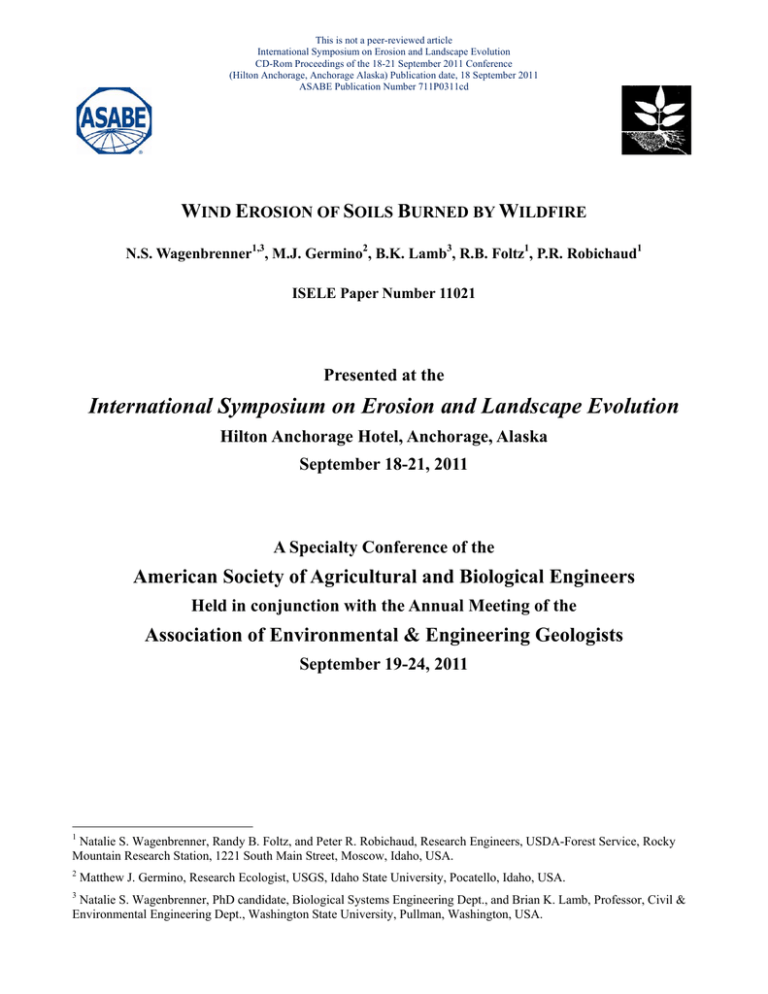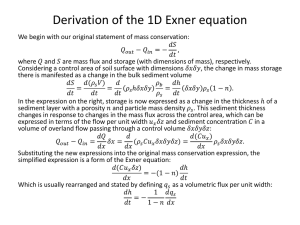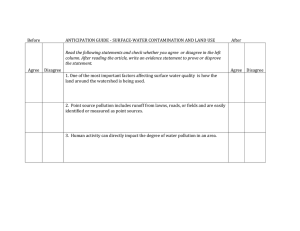Document 12872746
advertisement

This is not a peer-reviewed article International Symposium on Erosion and Landscape Evolution CD-Rom Proceedings of the 18-21 September 2011 Conference (Hilton Anchorage, Anchorage Alaska) Publication date, 18 September 2011 ASABE Publication Number 711P0311cd WIND EROSION OF SOILS BURNED BY WILDFIRE N.S. Wagenbrenner1,3, M.J. Germino2, B.K. Lamb3, R.B. Foltz1, P.R. Robichaud1 ISELE Paper Number 11021 Presented at the International Symposium on Erosion and Landscape Evolution Hilton Anchorage Hotel, Anchorage, Alaska September 18-21, 2011 A Specialty Conference of the American Society of Agricultural and Biological Engineers Held in conjunction with the Annual Meeting of the Association of Environmental & Engineering Geologists September 19-24, 2011 1 Natalie S. Wagenbrenner, Randy B. Foltz, and Peter R. Robichaud, Research Engineers, USDA-Forest Service, Rocky Mountain Research Station, 1221 South Main Street, Moscow, Idaho, USA. 2 3 Matthew J. Germino, Research Ecologist, USGS, Idaho State University, Pocatello, Idaho, USA. Natalie S. Wagenbrenner, PhD candidate, Biological Systems Engineering Dept., and Brian K. Lamb, Professor, Civil & Environmental Engineering Dept., Washington State University, Pullman, Washington, USA. WIND EROSION OF SOILS BURNED BY WILDFIRE N.S. Wagenbrenner1,3, M.J. Germino2, B.K. Lamb3, R.B. Foltz1, P.R. Robichaud1 ABSTRACT Wind erosion and aeolian transport processes are largely unstudied in the post-wildfire environment, but recent studies have shown that wind erosion can play a major role in burned landscapes. A wind erosion monitoring system was installed immediately following a wildfire in southeastern Idaho, USA to measure wind erosion from the burned area (Figure 1). This paper describes initial findings related to horizontal sediment flux and PM10 (particulate matter with a diameter of less than 10 µm) emissions from the burned area. Several wind erosion events were monitored in the months following the fire. The largest wind erosion event to-date occurred in early September 2010 and produced 570 kg m-1 of horizontal sediment transport within the first meter above the soil surface and generated a large dust plume that was visible in satellite imagery. The peak PM10 concentration measured on-site at a height of 2 m in the downwind portion of the burned area was 690 mg m-3. Measured horizontal sediment fluxes and PM10 vertical fluxes are on the upper end of values reported in the wind erosion literature. These initial results indicate that wildfire can convert a relatively wind-resistant landscape into one that produces as much soil and dust as some of the most wind erodible landscapes known, including the US southern high plains and the Loess Plateau in China. KEYWORDS. Wind erosion, Wildfire, Ash, PM10, Burned soil, Air quality. Figure 1. Left: the location and extent of the Jefferson Fire burned area. Right: monitoring equipment at the site. 1 Natalie S. Wagenbrenner, Randy B. Foltz, and Peter R. Robichaud, Research Engineers, USDA-Forest Service, Rocky Mountain Research Station, 1221 South Main Street, Moscow, Idaho, 83843, USA. 2 3 Matthew J. Germino, Research Ecologist, USGS, Idaho State University, Pocatello, Idaho, USA. Natalie S. Wagenbrenner, PhD candidate, Biological Systems Engineering Dept., and Brian K. Lamb, Professor, Civil & Environmental Engineering Dept., Washington State University, Pullman, Washington, USA. INTRODUCTION Wind erosion and aeolian sediment transport processes are largely unstudied compared to rainfallinduced soil erosion and fluvial sediment transport in post-wildfire environments. The work that has been done suggests that wind erosion can play a major role in burned landscapes. Whicker et al. (2006) measured more than an order of magnitude increase in dust emissions after a high-severity wildfire in northern New Mexico, USA and elevated dust emissions two and three years following the fire due to continuing drought conditions. Blowing dust and ash from the 2007 Milford Flat Fire Complex in Utah, USA forced periodic closures of a major interstate highway for months following the fire, and dust storms originating from the burned area in 2008 and 2009 have been associated with US Environmental Protection Agency (EPA) National Ambient Air Quality Standards (NAAQS) exceedances in a populated area over 100 km downwind (Miller et al., 2010). Burned soils are susceptible to particle entrainment by wind because fire consumes protective ground cover, soil organic matter, and soil-stabilizing root networks, destroys naturally occurring soil crusts (Ford and Johnson, 2006), can induce soil water repellency (Ravi et al., 2006), and decreases aggregate stability (Varela et al., 2010), all of which increase the wind erodibility of the soil. Blowing dust and ash from burned areas can impact visibility, air quality, soil productivity and nutrient transport (Miller et al., 2010; Whicker et al., 2006) and deposition of wind-blown dust and ash can have implications for water quality (Vicars et al., 2010) and snowmelt processes (Painter et al., 2010; Rhodes et al., 2010). In an effort to better understand and quantify the role of wind erosion in post-fire environments, we installed wind erosion monitoring equipment following a wildfire in southern Idaho, USA. This paper presents horizontal sediment flux and PM10 (particulate matter with a diameter of less than 10 µm) data measured in the burned area in the months following the fire. We provide an overview of PM10 and sediment flux data collected to-date and then detail two specific wind erosion events. METHODS Site Description The Jefferson Fire burned 44,110 ha of semi-arid sagebrush steppe in southeastern Idaho, USA (43º40’N, 112º35’W, elevation 1500 m) during July 2010. The fire followed a northeast trajectory and burned a strip of land nearly 50 km long and 8 km wide. Wind erosion monitoring equipment was installed in the downwind (northeast) portion of the burned area roughly two weeks after the fire was contained (Fig. 1). The fetch distance upwind of the monitoring equipment was 45 km. Average precipitation at the site is 280 mm yr-1 and prevailing winds are from the southwest. Soil depth ranges from 0 to greater than 200 cm and surface soils are predominantly loamy sands with up to 20 percent of the burned area covered by stony outcroppings of fractured basalt bedrock (NRCS Web Soil Survey). Unburned soils in this ecosystem are typically protected by a naturally occurring soil crust and natural wind erosion rates are low, with an average soil flux of 0.0003 g day-1 (Sankey et al., 2009). The terrain is relatively flat with slopes ranging from 2 to 20 percent. Pre-fire vegetation was comprised primarily of Wyoming big sagebrush (Artemisia tridentate ssp. wyomingenis Rydb.) and bluebunch wheatgrass (Agropyron spicatum Pursh.). The fire consumed nearly all of the vegetation, leaving only the exposed root bases of the sagebrush (Figure 1). Measurements Horizontal sediment flux was measured at three locations along a 50-m transect normal to the prevailing wind direction using BSNE passive sediment collectors (Custom Products and Consulting, 2 Big Spring, TX) with inlets at 5, 10, 20, 55, and 100 cm above the soil surface. Sediment was collected from BSNE collectors every two weeks and dried and weighed to determine sediment mass fluxes. PM10 vertical flux was measured at two locations along this same transect using E-Sampler Particulate Sensors (MetOne Instruments, Grants Pass, OR). Real-time (5-min average) PM10 concentrations were monitored at 2 and 5-m heights at each location. E-Sampler PM10 concentrations were calibrated against concentration readings from a Beta Attenuation Monitor (E-BAM 1020, MetOne Instruments, Grants Pass, OR) which is a US EPA approved method for monitoring ambient PM10 concentrations (Automated Equivalent Method: EQPM-0798-122; US EPA, 2011). Mean winds, temperature and turbulence were monitored with a CSAT3 sonic anemometer (Campbell Scientific, Logan, UT) operated at 10 Hz at a height of 5 m. Hourly relative humidity, solar radiation, precipitation, soil temperature, and soil moisture were also recorded throughout the study period. Vertical flux of PM10 was calculated as Fv = ku* (C1 − C2 ⎛z ⎞ ln⎜⎜ 2 ⎟⎟ ⎝ z1 ⎠ where k is the von Karman constant, u* is friction velocity, and C1 and C2 are PM10 concentrations at heights z1 and z2, respectively. This calculation assumes neutral stability conditions which is appropriate for the strong wind conditions that produce measureable dust fluxes. Sediment flux was determined for each two-week sampling interval by fitting the vertical distribution of soil mass caught by the BSNE collectors to a power function of the form q = az-b where q is the mass of sediment caught per unit width at each height, z, and a and b are fitted parameters. RESULTS Winds were predominantly from the southwest with speeds of up to 19 m s-1, although winds of up to 10 m s-1 were also recorded from the northeast (Fig. 2). Horizontal sediment fluxes ranged from 156 to more than 570 kg m-1 for the first month following the fire. The largest peak in sediment flux occurred during the strongest wind event monitored to-date during 4-5 September 2010. The measured sediment fluxes were more than ten orders of magnitude larger than values reported by Sankey et al. (2009) for natural conditions in this area. Although PM10 data were not available between 1-30 August 2010, based on observed wind speeds and sediment fluxes, we suspect that PM10 concentrations were elevated on a nearly daily basis, with spikes in concentration on a few particularly windy days such as 17 August (Figure 2). Despite these suspected earlier emissions, based on the high sustained wind speeds and relative peak in sediment flux, we believe the largest PM10 emissions occurred during the 4-5 September 2010 event making this event the largest in terms of both sediment flux and PM10 emissions. Sediment fluxes and PM10 emissions were smaller after the 4-5 September event, likely due to decreased availability of erodible surface material; however, there was a substantial increase in sediment flux in early November prior to snowfall. This suggests there was still sufficient erodible soil available to produce dust emissions. This further suggests that elevated emissions may continue after the spring snowmelt, although the effects of snowmelt and drying on these soils are uncertain. While PM10 emissions and sediment fluxes were smaller during mid-September to November as compared to 3 July to early September, they were still in the mid to high range of values reported for agricultural soils (Kjelgaard et al., 2004; Sharratt et al., 2007; Zobeck and Van Pelt, 2006). 4-5 September Event The 4-5 September event occurred during the passage of a strong frontal system which brought sustained daytime winds of up to 19 m s-1 and nighttime wind speeds of 6 m s-1 (Figure 3). Sediment completely filled the lower three collectors of BSNE sediment traps during the two week period which included this wind event, so the calculated horizontal sediment flux value of 570 kg m-1 (Figure 2) was an underestimate. This value was of the same order of magnitude of sediment fluxes reported during wind erosion events on agricultural fields in northwestern Texas (Van Pelt, 2004) and the Loess Plateau in China (Dong et al., 2010). Figure 2. Overview of post-fire meteorology and sediment transport from 28 August to 3 November 2010. PM10 concentrations are 5-min average concentrations measured 2 m above the soils surface. Sediment flux was measured within the first meter of the soil surface. Real-time PM10 concentrations followed trends in wind speed and friction velocity data throughout the monitoring period (Figure 2), and a peak concentration of 690 mg m-3 (Figure 3) was measured during 4-5 September event. This was two orders of magnitude larger than PM10 concentrations reported from dust events on the Columbia Plateau of central Washington (Sharratt et al., 2007) and three orders of magnitude larger than those reported during dust events on the US southern high plains (Stout, 2001). A dust plume originating from the burned area on 4 September was visible in MODIS satellite imagery and extended at least 100 km downwind of the source area (Figure 4). The satellite imagery clearly depicted the burned area as the source of dust emissions during this high wind event and provided visual evidence of the areal extent of the dust emissions. 4 Figure 3. Observed wind speed, wind direction, friction velocity, and PM10 concentration for the 4-5 September 2010 event. 3-4 October Event The 3-4 October event occurred when nighttime southerly winds increased to 6 m s-1 around 23:30 on 3 October. This event included a series of several spikes in wind speed and PM10 concentrations over the span of several hours (Figure 5). Sediment flux for the two-week period which included this event was 26 kg m-1 (Figure 2). PM10 concentrations tracked closely with wind speed and the largest spike of 40 mg m-3 occurred at midnight on 3 October when wind speed increased from around 7 to 14 m s-1 for about 10 minutes. Calculated maximum PM10 vertical fluxes during the three distinct peaks shown in Fig. 5 were 4283, 1510, 1093 µg m-2 s-1. Although smaller than the earlier September event, this event nonetheless constituted a major wind erosion episode with sediment fluxes of the same order of magnitude as those reported from wind erosion events measured from other types of disturbed soils (Sharratt et al., 2007; van Donk et al., 2003) and PM10 vertical fluxes larger than those reported from agricultural soils (Kjelgaard et al., 2004; Zobeck and Van Pelt, 2006) 5 Figure 4. MODIS satellite imagery showing the burn scar on 19 July 2010 (top) and a dust plume originating from the burned area on 5 September 2010 (bottom). Arrows indicate the ignition point of the fire. 6 Figure 5. Observed wind speed, wind direction, friction velocity, and PM10 concentrations for the 3-4 October 2010 events. CONCLUSION On-site horizontal sediment flux and PM10 concentration measurements provided a quantitative account of the wind erosion in the burned area. Satellite images complemented these ground-based measurements and depicted the areal extent of a large dust plume during one large wind erosion event. These results demonstrate that particulate emissions from burned areas can be extremely high and potentially result in both local and downwind impacts. Measurements indicate that wildfire can convert a relatively wind erosion-resistant landscape into a highly erodible source of particulate emissions. Burned soils can produce large sediment fluxes, comparable to those of the most wind erodible landscapes in the US, as well as high vertical fluxes of PM10, with estimated values near the upper end of values reported from other types of soil disturbance. Acknowledgements We thank Ben Kopyscianski, Bob Brown, and Cassie Byrne from the Rocky Mountain Research Station for assistance with installation and maintenance of field equipment and Amber Hoover from Idaho State University for help with data collection and laboratory analyses. Funding for this project was provided by the Bureau of Land Management and US Department of Defense. REFERENCES 1. Dong, Z., D. Man, W. Luo, G. Qian, J. Wang, M. Zhao, S. Liu, G. Zhu, and S. Zhu. 2010. Horizontal aeolian sediment flux in the Minqin area, a major source of Chinese dust storms. Geomorph. 116: 58–66. 7 2. Ford, P.L., and G.V. Johnson. 2006. Effects of dormant- vs. growing-season fire in shortgrass steppe: Biological soil crust and perennial grass responses. J. Arid Environ. 67: 1–14. 3. Kjelgaard, J., B. Sharratt, I. Sundram, B. Lamb, C. Claiborn, K. Saxton, and D. Chandler. 2004. PM10 emission from agricultural soils on the Columbia Plateau: comparison of dynamic and timeintegrated field-scale measurements and entrainment mechanisms. Agr. Forest Meteorol. 125: 259– 277. 4. Miller, M.E., R.L. Reynolds, H. Goldstein, M.C. Reheis, and J.C. Yount. 2010. Wildfire, land management, and aeolian processes in dryland ecosystems–lessons from the Milford Flat Fire. American Geophysical Union Fall Meeting Abstracts, Dec. 2010. No. B33B-0410. 5. NRCS Web Soil Survey. Available at: websoilsurvey.nrcs.usda.gov/app. Accessed April 2011. 6. Painter, T.H., J.S. Deems, J. Belnap, A.F. Hamlet, C.C. Landry, and B. Udall. 2010. Response of Colorado River runoff to dust radiative forcing in snow. P. Natl. Acad. Sci. 107(40): 17125–17130. 7. Ravi, S., P. D’Odorico, T.M. Zobeck, T.M. Over, and S.L. Collins. 2007. Feedbacks between fires and wind erosion in heterogeneous arid lands. J. Geophys. Res. 112. G04007, doi:10.1029/2007JG000474. 8. Rhodes, C., K. Elder, and E. Greene. 2010. The influence of an extensive dust event on snow chemistry in the Southern Rocky Mountains. Arct. Antarct. Alpn. Res. 42(1): 98–105. 9. Sankey, J.B., M.J. Germino, and N.J. Glenn. 2009. Aeolian sediment transport following wildfire in sagebrush steppe. J. Arid Environ. 73: 912–919. 10. Sharratt, B., G. Feng, and L. Wendling. 2007. Loss of soil and PM10 from agricultural fields associated with high winds on the Columbia Plateau. Earth Surf. Proc. Land. 32: 621–630. 11. Stout, J.E. 2001. Dust and environment in the southern high plains of North America. J. Arid. Environ. 47: 425–441. 12. US EPA. 2011. 40 CFR Part 53. Ambient air monitoring reference and equivalent methods. 13. van Donk, S.J., X. Huang, E.L. Skidmore, A.B. Anderson, D.L. Gebhart, V.E. Prehoda, and E.M. Kellogg. 2003. Wind erosion from military training lands in the Mojave Desert, California, USA. J. Arid Environ. 54: 687–703. 14. Van Pelt, R.S., T.M. Zobeck, K.N. Potter, J.E., Stout, Popham, T.W. 2004. Validation of the wind erosion stochastic simulator (WESS) and the revised wind erosion equation (RWEQ) for single events. Environ. Modell. Softw. 19: 191–198. 15. Varela, M.E., E. Benito, and J.J. Keizer. 2010. Effects of wildfire and laboratory heating on soil aggregate stability of pine forests in Galicia: The role of lithology, soil organic matter content and water repellency. Catena 83: 127–134. 16. Vicars, W.C., J.O. Sickman, and P.J. Ziemann. 2010. Atmospheric phosphorus deposition at a montane site: Size distribution, effects of wildfire, and ecological implications. Atmos. Environ. 44(24): 2813–2821. 17. Whicker, J.J., J.E. Pinder, and D.D. Breshears. 2006. Increased wind erosion from forest wildfire: Implications for contaminant-related risks. J. Environ. Qual. 35(2): 468–478. 18. Zobeck, T.M., and R.S. Van Pelt. 2006. Wind-induced dust generation and transport mechanics on a bare agricultural field. J. Hazard. Mater. 132: 26–38. 8





